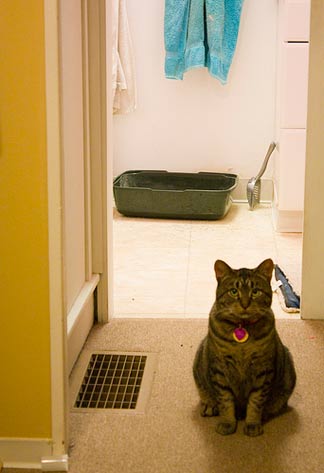Feline Urinary Issues: Common Medical Causes of Inappropriate Urination
When an owner brings his or her cat to the veterinarian with a complaint that points towards the lower urinary tract (i.e., the urethra, bladder, and/or ureters), the doctor will start the workup by performing a physical examination and a urinalysis. Depending on the results of these two procedures, blood work, abdominal X-rays, an abdominal ultrasound, and/or a urine culture may also be needed.
Diagnostic testing is necessary to differentiate between the different diseases that can affect the lower urinary tract of cats, all of which produce similar symptoms. These include:
- urinating outside of the litter box
- straining to urinate
- producing only a small amount of urine at any given time
- increased frequency of urination
- crying out during urination
- discolored (often pink or red) urine
Today, let’s look at three of the most common diseases that produce these clinical signs.
Feline Idiopathic Cystitis (FIC)
Feline Idiopathic Cystitis (FIC) is also called Idiopathic Feline Lower Urinary Tract Disease (IFLUTD), Feline Urologic Syndrome (FUS), or Interstitial Cystitis. Warning! Whenever one condition goes by several different names, it is a good indication that doctors do not completely understand it. This is certainly the case with FIC.
FIC is a diagnosis of exclusion. A cat that has some of the symptoms associated with lower urinary tract disease is said to have FIC after appropriate diagnostic testing has shown no underlying cause for the symptoms. This is a frustrating situation for pet owners and veterinarians alike, but FIC is diagnosed in 55-60 percent of cats with lower urinary tract disease.
One hallmark of FIC is the tendency for symptoms to disappear with or without treatment, but then flare up again with varying degrees of intensity and frequency.
Bladder Stones
Yes, cats get bladder stones. Large ones are usually visible on X-rays; smaller ones may require an abdominal ultrasound for diagnosis. Typically, feline bladder stones (or uroliths, as doctors like to call them) are composed of either struvite or calcium oxalate crystals. While this may sound like an esoteric distinction, this determination is actually very important when planning treatment. Struvite stones will usually dissolve when a cat eats a specific type of food or is treated with a urinary acidifier, while calcium oxalate stones require surgery to remove them (more on this in a future post).
Veterinarians can usually determine what type of stone a cat has by examining a urine sample under the microscope, looking for one type of crystal versus the other. Evaluating the pH of a cat’s urine also helps with the diagnosis.
Bacterial Infection
Urinary tract infections (UTI) are not all that common in young, otherwise healthy cats. The incidence increases as cats age, or if they have a predisposing condition, like diabetes mellitus. To definitively diagnose a urinary tract infection, a veterinarian should see bacteria in a urine sample taken via sterile technique, or be able to grow bacterial colonies via a urine culture.
Urinary tract infections are over diagnosed in cats. Here is a typical situation: A cat presents with signs of lower urinary tract disease, and the vet sees evidence of inflammation on the urinalysis. Keep in mind that while inflammation is often seen with bacterial infections, it is also present with FIC. The vet prescribes an antibiotic "to be on the safe side," and the cat gets better. Understandably, the owner thinks the infection was cured by the antibiotic. However, the more likely explanation is that the cat actually has FIC and its current flare-up resolved independently of treatment.
If this scenario occurs only once or twice in a cat’s life, no big deal. But, if a cat is diagnosed with recurrent urinary tract infections and is repeatedly treated with antibiotics, beware. Either the cat has an underlying condition that predisposes it to UTI’s (e.g., an anatomical abnormality), or the real problem is FIC.
We’ll talk about treatment options in an upcoming article, but first we need to tackle one more very serious disease seen primarily in male cats.
Next week: The Blocked Cat

Dr. Jennifer Coates
Pic of the day: Day 363/365 - Somewhere, somehow, a cat is watching you by Tony Case

